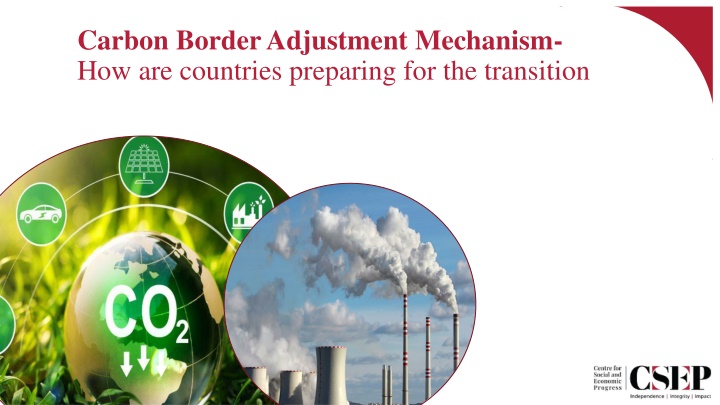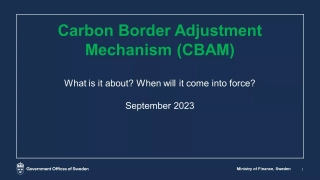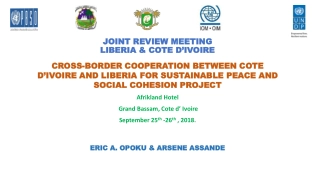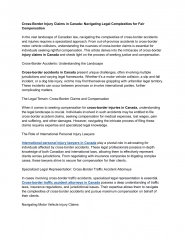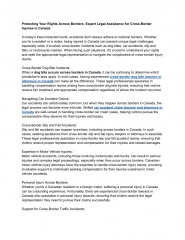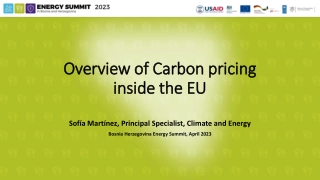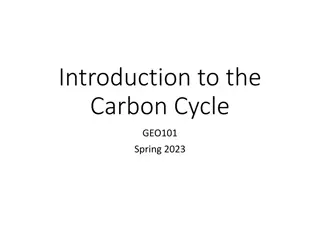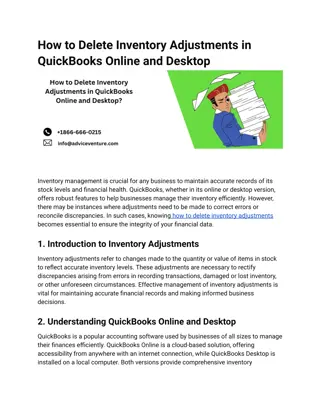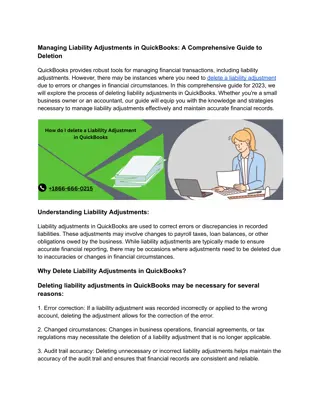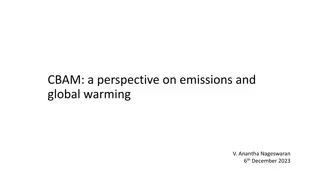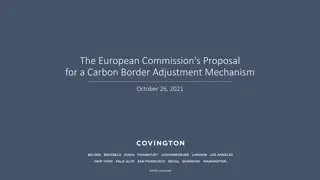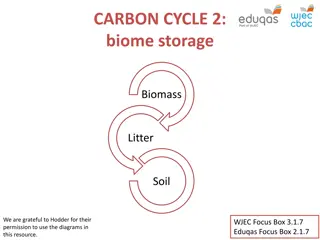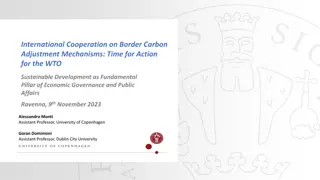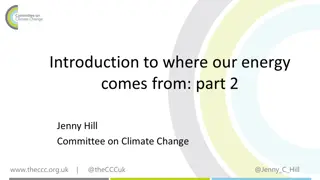Transitioning to Carbon Border Adjustment Mechanisms: Preparation Efforts
As the implementation of Carbon Border Adjustment Mechanisms approaches, countries are gearing up for the transition. This involves setting up frameworks, assessing impacts on trade, and aligning policies with climate goals. Governments are working on strategies to ensure smooth adaptation to the new mechanisms, which aim to curb carbon leakage and promote sustainability in cross-border trade.
Download Presentation

Please find below an Image/Link to download the presentation.
The content on the website is provided AS IS for your information and personal use only. It may not be sold, licensed, or shared on other websites without obtaining consent from the author.If you encounter any issues during the download, it is possible that the publisher has removed the file from their server.
You are allowed to download the files provided on this website for personal or commercial use, subject to the condition that they are used lawfully. All files are the property of their respective owners.
The content on the website is provided AS IS for your information and personal use only. It may not be sold, licensed, or shared on other websites without obtaining consent from the author.
E N D
Presentation Transcript
Carbon Border Adjustment Mechanism- How are countries preparing for the transition
Introduction to CBAM Emissions Coverage: Scope 1 (Direct) Scope 2 (Indirect) Aim: Coverage: Counter measure against Carbon Leakage Equalising the price of Carbon between domestic products and imports Iron and Steel Countries: Non-EU countries, including India, that export carbon-intensive goods to the EU (Iceland, Norway, and Switzerland exempted) Aluminium Production in Europe Production Abroad Cement EU ETS charging domestic industries for their carbon emissions CBAM certificates to be purchased by EU importers to cover difference between EU and non-EU CO2 cost Exemptions: If a non-EU producer has already paid a carbon price in a third country on the embedded emissions for the production of the imported goods, the corresponding cost fully/partially deducted from the CBAM obligation. Fertilizer Electricity can be Hydrogen Equal Carbon Pricing 2
Rollout Roadmap 1 2 4 3 starting January 2026, exporters will start paying the Carbon Border Tax on Aluminium and Steel and other covered products. 27 month transition period No tax payment Details of carbon content to be shared starting 2034, by this time, all the goods and materials imported into the EU and covered by EU ETS will be will extend from 2026 to 2034, when new products will be taxed under CBAM. Mars Despite being red, Mars is a cold place full of iron oxide dust taxed under CBAM.
India: Iron & Steel (24%), Aluminium (9.1%) most exposed Aluminium Absolute Exposure Iron and Steel Relative Exposure Absolute Exposure Relative Exposure 0.12 0.11 0.07 0.07 0.10 0.09 0.06 0.06 0.08 0.05 0.06 0.04 0.05 0.05 0.05 0.05 0.05 0.04 0.04 0.04 0.03 0.04 0.03 0.02 0.02 0.02 0.02 0.02 0.02 0.01 0.02 0.02 0.01 0.01 0.02 0.01 0.01 0.01 0.00 0.00 0.00 0.00 0.00 0.00 0.00 - - Zimbabwe Albania Ukraine India Egypt, Arab Rep. Venezuela Russian Federation Absolute Exposure Absolute Exposure 0.01 0.00 Relative Exposure Relative Exposure 0.00 0.00 Absolute Exposure Absolute Exposure 0.01 0.00 Relative Exposure Relative Exposure 0.01 0.00 Mean Value Mean Value Median Value Median Value Mean Value Mean Value Median Value Median Value 5
Extensive compliance and reporting a challenge for firms Direct and Indirect emissions Specific CN/HS codes Geographic information, installation information, production route Third party verified Default values if information not provided Carbon price paid in domestic country Importers registration Penalty for non compliance 6
How are countries preparing for CBAM? Governments Negotiations with the EU/Signing new FTAs Providing guidance and support to businesses. Developing their own domestic carbon markets/CBAM Improving Monitoring, Reporting and verification systems (MRV) Promoting renewable energy by funding R&D, regulations, incentives, setting targets etc. Collaborating with international institutions such as EBRD, WB to fund projects Assessing country's exposure to CBAM 8
Cross Country Comparison Domestic carbon markets Promoting renewable energy Assessing exposure to CBAM Guidance and support to businesses Improving MRV mechanisms Country Name Institutional Collaboration Negotiations India Turkiye Indonesia Egypt China S. Korea UK USA Japan Vietnam Ukraine n/a n/a n/a n/a n/a n/a (own CBAM) n/a (own CBAM) n/a (own CBAM) n/a n/a n/a n/a n/a n/a n/a 9
Measures by Governments- Examples India Establish its own Carbon Credit Trading System- CCTS Seeking exemptions For MSMEs through FTAs Recognition of its carbon verifiers Push for Green Steel with pilots running - the steel ministry is preparing a blueprint for green steel production Initiatives to scale up Net- Zero Technologies like Carbon Capture and Storage (CCS) plants are underway Selective Export Tax under consideration as per news reports Turkiye Decided to commit to the Paris goals under the influence of the EU CBAM Announced its Green Deal Action Plan and Hydrogen Technologies Strategy and Roadmap The EBRD is working with Turkey in multiple ways to strengthen Turkish interest in carbon pricing Developing sector-specific decarbonization road maps for crucial industries, including steel, aluminium, cement and fertilizer. 10
Measures by Governments- Examples Indonesia The government launched the Indonesia Carbon Exchange (IDXCarbon) Egypt Unveiled National Climate Change Strategy 2050. The Egyptian Government plans to execute this strategy through issuance of green bonds, and procurement of funds via the World Bank, the European Bank for Reconstruction and Development (EBRD), and other financial institutions Japan Launched a voluntary national market for carbon offsets China Expanding its already existing ETS which currently covers only power sector to cover sectors eligible under the EU s CBAM Establishing national accounting and verification systems and standards for emissions-intensive industrial companies Vietnam and Ukraine 11 Plan to establish their own ETS
Measures by Governments- Examples South Korea Requested that offshore manufacturing companies be allowed to submit data directly to the CBAM registry to protect confidentiality Asked for the allowance of adoption of the K-ETS standard to calculate embodied carbon emissions Asked for elimination of transition period penalties Korea has also been discussing its own CBAM system. United Kingdom Working on the legislative process to establish its own CBAM Linking its domestic ETS with EU ETS as the scheme is modelled on their scheme Mandatory product standards (MPS) promoting the market for low carbon goods United States Considering its own CBAM 12
How are countries preparing for CBAM? Industries Internal carbon pricing/ setting up emissions targets Conducting a thorough assessment of their carbon emissions Investing in low- carbon/carbon capture technologies Engaging with different stakeholders such as suppliers, customers, investors , employees, and policymakers Assessing the impact of CBAM Enhancing measuring, reporting, and verification mechanisms Preparing documents related to emission related details, re working contracts, undergoing emission audits etc. 13
Measures by Indian Companies Jindal Stainless Involving third parties for automating emissions reports HINDALCO Incorporating internal carbon pricing Implementation of innovative technologies like Carbon capture, red mud neutralisation with CO2, Zero Waste to landfill Kalyani Steel Utilizing solar power in its electric arc furnace Arcelor Mittal Joining platforms for net-zero transition such as Energy Transition Commission (ETC), the World Economic Forum, the Centre for Climate Aligned Finance, IEA, and SBTI Tata Steel Carried out trials with hydrogen injection in blast furnaces Commissioned a carbon capture plant Set up a steel recycling plant Engages with suppliers to assess their environmental performance SAIL Vedanta Adopting internal carbon price Launched Restora , India s first low carbon green aluminium Bolstering domestic coking coal production Alternate Markets Exploring sustainable solutions with SMS Group 14
Measures by Foreign Companies (Steel) European Union H2 Green Steel: signed contracts with automotive and construction companies that emissions steel. contracts to raise $105 million. Building a steel plant using green hydrogen China Ukraine Baowu Steel Group: Hydrogen steelmaking and reduction Jianlong Steel and Bayi Steel using smelting reduction HYBRIT Model: Pilot underway Metivest: Focus on hydrogen, natural gas, and improving the quality of raw materials. Projects include: Cold rolling mill and colour-coated rolled steel smelting need Used low- these United States Russia Brazil Nucor Steel: Technologies like off-gas heat recovery, burner improvement, highly efficient power supply systems, scrap preheating alternatives, carbon sequestration Transparency in reporting Reduction of fuel and flux consumption due to increased Fe content in concentrate Rotating air heater replacement Turbine air blower Gerdau: Joint venture with Shell for solar energy generation to be used in Steel production 15
Measures by Foreign Companies (Aluminium) South Africa Hulamin: Greenhouse gas emissions target approved by the Science Based Targets Initiative Measures to prevent waste mixing and contain spillages/leaks Engaging with the value chain on environmental issues Educating employees on responsible use of resources Russia Egypt Rusal: partnered with companies producing high-quality aluminium alloys Promoting enhanced product traceability (ALLOW digital passport) Advocates for CO2 disclosure Egyptalum: Aligning operations with the Aluminium Stewardship Initiative ASI's rigorous standards 16
Issues for Discussion What are the gaps/deficits in the current Indian responses? What other forms of stakeholder engagements are required? What further/ additional expectations from the EU authorities? CBAM s conformity to WTO principles How to address emissions embedded in Supply Chains across countries? Any structural impact? How can firms be incentivised for gradual/ eventual alignment with CBAM? Potential measures to help MSMEs cope with CBAM Accounting of ESCerts trading under PAT scheme and RECs under RPOs in the CCTS?- ETS Mismatch Verification, training/skilling, familiarisation, communication, feedback mechanisms Are the above enough to retain competitiveness? Can India gain from opportunities, e.g., export tax, technology, etc.? 17
